Today’s item will mark the blog’s first post on otters, as we’re covering the sea otter (Enhydra lutris). Sea otters are part of the Lutrinae subfamily of mustelids that includes all of the genera of otters. Three subspecies are recognized between the Asian sea otter in Russia and northern Japan, the northern sea otter in Alaska, and the southern sea otter in California. Sea otters represent one of the smallest marine mammals, but the heaviest of extant mustelids. Adults range from 1-1.5 meters in length and 14-45 kilograms, with males being larger than females. These animals have social tendencies, living in sex-segregated groups, but are fairly independent creatures otherwise. Sea otters have a wide diet, mainly spanning benthic invertebrates, including a variety of mollusks, crustaceans, and invertebrates. Their consumption of sea urchins is important as this aids the management of underwater plants, with depleted populations and historical ranges leading to areas of lost kelp forests. Due to extensive hunting for their thick fur, the historical sea otter range of 150,000-300,000 individuals was reduced to 2,000, with current numbers sitting at 107,000. The southern subspecies experienced the lowest recovery, still hovering at 3,000. The sea otter’s IUCN status remains ”Endangered” due to even recovering populations remaining sensitive to human impact. Parasite-conferring urban runoff in addition to the otter’s diet overlapping with economically important food sources challenges the sea otter’s recovery. The sea otter’s predators include sea lions and orcas. Great white sharks have been known to kill sea otters, but very little evidence assumes these sharks actually hunt them as prey.
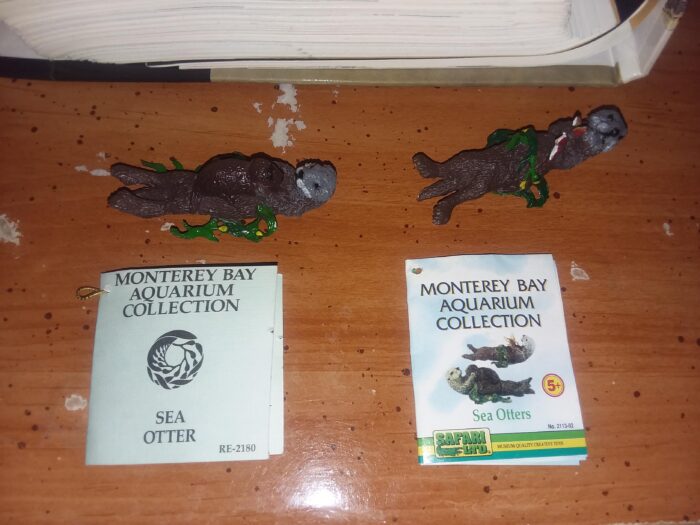
This review will return to Safari Ltd.’s Monterey Bay Aquarium line, where these institutions collaborated to produce a scaled line of 1:20 and 1:40 scale sea creatures in a similar vein as the Carnegie Collection. After almost 30 years, 14 out of the 24 releases are still in production. The sea otter pair was among the original figures released in 1992. Since the MBA line prioritized depicting local species, it can be reasonably assumed that these figures specifically represent the southern subspecies.
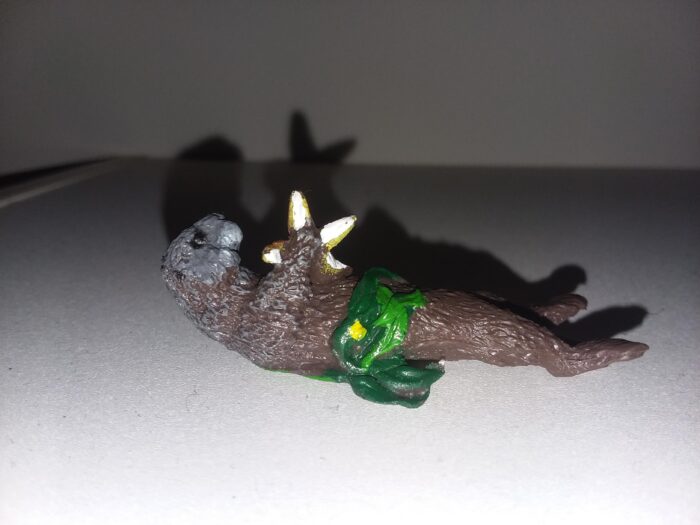
Both members of this pair measure at the same length, just around 6.4cm. The sea otter pair was marketed as part of the 1:20 scale portion of this collection, placing it at them at 1.28 meters, average sizes for both sexes. Both are posed supine, as they are often observed at the ocean’s surface.
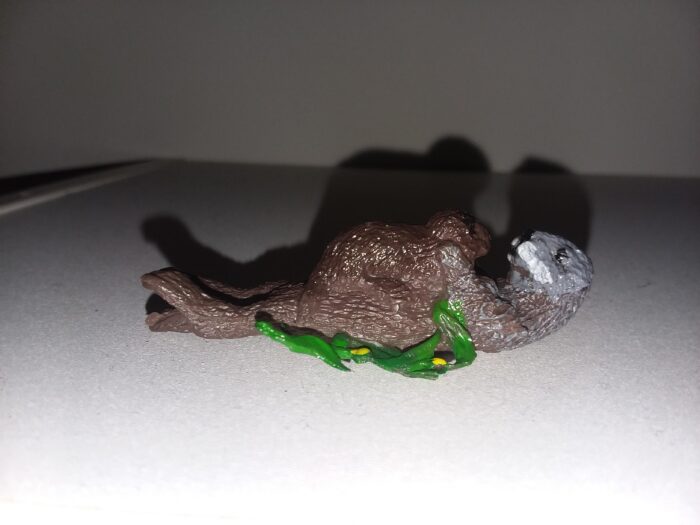
These otters were sold together as a marketed ”pair”, but technically these figures are inherently an adult pair + pup set. Unlike the whale calves of the MBA line, the sea otter’s pup is sculpted into one piece with its mother. There’s also a string of kelp surrounding the mother. Overall, these figures are very nicely sculpted for this scale. The texture is there for the fur and the features of the face and feet are quite noticeable.
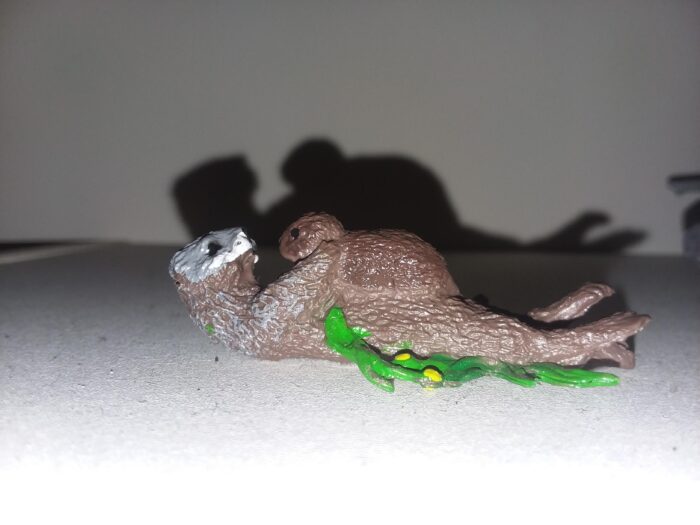 The paintjob is also quite nice. The base color is brown while the face colored gray with a white upper lip. Now as far as I was able to find, the sea otter’s face is supposed to be more of a light tan color rather than grey. There exists two other paint jobs for these figures, and the pair I own appears to be one of the older color schemes. One is similar to this paintjob, except the kelp is lighter while the other has red kelp and a tan face, more similar to what these creatures appear in real life. Otherwise, the paintjob is quite nice on this figure.
The paintjob is also quite nice. The base color is brown while the face colored gray with a white upper lip. Now as far as I was able to find, the sea otter’s face is supposed to be more of a light tan color rather than grey. There exists two other paint jobs for these figures, and the pair I own appears to be one of the older color schemes. One is similar to this paintjob, except the kelp is lighter while the other has red kelp and a tan face, more similar to what these creatures appear in real life. Otherwise, the paintjob is quite nice on this figure.
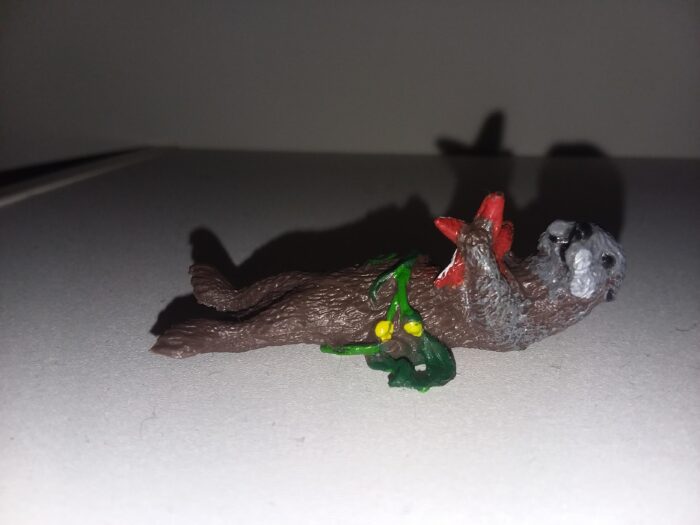
This figure is posed similarly to the mother, though holding a starfish for lunch rather than tending to a pup and looking slightly off towards the left. One can assume this figure could have been intended to be a male, but strictly speaking, this figure is sex-neutral. Otherwise, the paint scheme and sculpting quality are the same as the mother.

On the backs of each figure are the imprint stamps. Reflective of how these are the smallest figures in the entire line, it’s the only time that it was necessary for ”Monterey Bay Aquarium” to be abbreviated to ”MBA”.
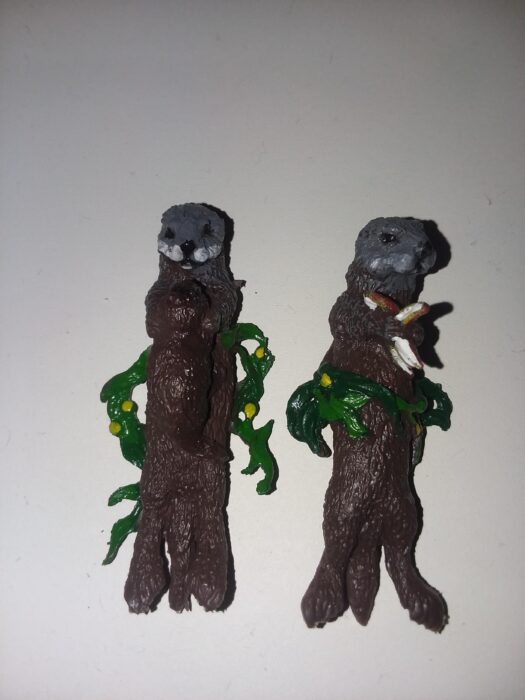
The MBA sea otter pair certainly lands as among the more impressive figures of the MBA collection in my opinion. These figures have aged quite well and I definitely consider these to be among the better sea otter figures released at this scale. However, it helps that there aren’t too many out there. Unfortunately, the sea otters are among the 10 figures in this collection to have been retired. The MBA pair’s replacement was an Incredible Creatures figure, which was also retired in 2013. So until Safari Ltd. brings a sea otter in its Sea Life collection, most people will need to resort to the secondhand market to get these figures.
Disclaimer: links to Ebay and Amazon on the AnimalToyBlog are affiliate links, so we make a small commission if you use them. Thanks for supporting us!




I have this pair. Bought one on eBay which I thought was sufficient for my needs, but I liked it so much I had to hunt down its mate.